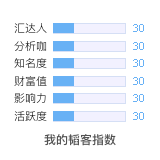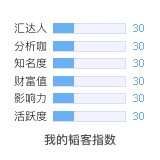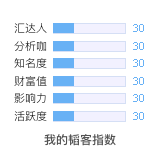[MT4指标]各类经济指标
Economic indicators
The Gross National Product (GNP). The Gross National Product measures the economic
performance of the whole economy. This indicator consists, at macro scale, of the sum of consumption
spending, investment spending, government spending, and net trade. The gross national product refers to the
sum of all goods and services produced by United States residents, either in the United States or abroad.
The Gross Domestic Product (GDP). The Gross Domestic Product refers to the sum of all goods
and services produced in the United States, either by domestic or foreign companies. The differences
between the two are nominal in the case of the economy of the United States. GDP figures are more
popular outside the United States. In order to make it easier to compare the performances of different
economies, the United States also releases GDP figures.
Consumption Spending. Consumption is made possible by personal income and discretionary
income. The decision by consumers to spend or to save is psychological in nature. Consumer
confidence is also measured as an important indicator of the propensity of consumers who have discretionary
Investment Spending. Investment — or gross private domestic spending — consists of fixed
Government Spending. Government spending is very influential in terms of both sheer size and its
impact on other economic indicators, due to special expenditures. For instance, United States military
expenditures had a significant role in total U.S. employment until 1990. The defense cuts that occurred at
the time increased unemployment figures in the short run.
Net Trade. Net trade is another major component of the GNP. Worldwide internationalization and
the economic and political developments since 1980 have had a sharp impact on the United States' ability to
compete overseas. The U.S. trade deficit of the past decades has slowed down the overall GNP. GNP
can be approached in two ways: flow of product and flow of cost.
Industrial sector indicators
Industrial Production indicator consists of the total output of a nation's plants, utilities, and
mines. From a fundamental point of view, it is an important economic indicator that reflects the strength of
the economy, and by extrapolation, the strength of a specific currency. Therefore, foreign exchange traders
use this economic indicator as a potential trading signal.
Capacity utilization indicator consists of total industrial output divided by total production
capability. The term refers to the maximum level of output a plant can generate under normal business
conditions. In general, capacity utilization is not a major economic indicator for the foreign exchange
market. However, there are instances when its economic implications are useful for fundamental analysis.
A "normal" figure for a steady economy is 81.5 percent. If the figure reads 85 percent or more, the
data suggests that the industrial production is overheating, that the economy is close to full capacity.
High capacity utilization rates precede inflation, and expectation in the foreign exchange market is
that the central bank will raise interest rates in order to avoid or fight inflation.
Factory orders. Refer to the total of durable and nondurable goods orders. Nondurable goods
consist of food, clothing, light industrial products, and products designed for the maintenance of durable
goods. Durable goods orders are discussed separately. The factory orders indicator has limited significance
for foreign exchange traders.
Durable goods orders. Consist of products with a life span of more than three years. Examples of
durable goods are autos, appliances, furniture, jewelry, and toys. They are divided into four major
categories: primary metals, machinery, electrical machinery, and transportation.
In order to eliminate the volatility pertinent to large military orders, the indicator includes a
breakdown of the orders between defense and non-defense.
This data is fairly important to foreign exchange markets because it gives a good indication of
consumer confidence. Because durable goods cost more than nondurables, a high number in this
indicator shows consumers' propensity to spend. Therefore, a good figure is generally bullish for the
domestic currency.
Business inventories. Consist of items produced and held for future sale. The compilation of this
information is facile and holds little surprise for the market. Moreover, financial management and
computerization help control business inventories in unprecedented ways. Therefore, the importance of this
indicator for foreign exchange traders is limited.
Construction Data
Construction indicator constitutes significant group that are included in the calculation of the GDP
of the United States. Moreover, housing has traditionally been the engine that pulled the U.S. economy out
of recessions after World War II. These indicators are classified into three major categories:
1. housing starts and permits
2. new and existing one-family home sales; and
3. construction spending.
Construction indicators are cyclical and very sensitive to the level of interest rates (and
consequently mortgage rates) and the level of disposable income. Low interest rates alone may not be able
to generate a high demand for housing, though. As the situation in the early 1990s demonstrated,
despite historically low mortgage rates in the United States, housing increased only marginally, as a result
of the lack of job security in a weak economy. Besides, in spite of the 2000 – 2001 recession the cost of houses,
for example in California, was practically not decreased.
Housing starts between one and a half and two million units reflect a strong economy, whereas a
figure of approximately one million units suggests that the economy is in recession.
Inflation indicators
Traders watch the development of inflation closely, because the method of choice for fighting
inflation is raising the interest rates, and higher interest rates tend to support the local currency. To
measure inflation traders use economic tools considered below.
Producer price index (PPI). It’s compiled from most sectors of the economy, such as
manufacturing, mining, and agriculture. The sample used to calculate the index contains about 3400
commodities. The weights used for the calculation of the index for some of the most important groups
are: food—24 percent; fuel—7 percent; autos—7 percent; and clothing—6 percent. Unlike the CPI, the
PPI does not include imported goods, services, or taxes.
Consumer price index (CPI). Reflects the average change in retail prices for a fixed market
basket of goods and services. The CPI data is compiled from a sample of prices for food, shelter, clothing,
fuel, transportation, and medical services that people purchase on daily basis. The weights attached for
the calculation of the index to the most important groups are: housing—38 percent; food—19 percent;
fuel—8 percent; and autos—7 percent.
The two indexes, PPI and CPI, are instrumental in helping traders measure inflationary activity,
although the Federal Reserve takes the position that the indexes overstate the strength of inflation.
Gross national product implicit deflator. It’s calculated by dividing the current dollar GNP
figure by the constant dollar GNP figure.
Gross domestic product implicit deflator. It’s calculated by dividing the current dollar GDP
figure by the constant dollar GDP figure.
Both the GNP and GDP implicit deflators are released quarterly, along with the respective GNP
and GDP figures. The implicit deflators are generally regarded as the most significant measure of inflation.
Commodity research bureau's (CRB) futures index . The Commodity Research Bureau's
Futures Index makes watching for inflationary trends easier. The CRB Index consists of the equally
weighted futures prices of 21 commodities. The components of the CRB Index are:
Precious metals: gold, silver and platinum
Industrials: crude oil, heating oil, unleaded gas, lumber, copper, and cotton
Grains: corn, wheat, soybeans, soy meal, soy oil
Livestock and meat: cattle, hogs, and pork bellies
Imports: coffee, cocoa, sugar
Miscellaneous: orange juice
The preponderance of food commodities makes the CRB Index less reliable in terms of general
inflation. Nevertheless, the index is a popular tool that has proved quite reliable since the late 1980s.
The “Journal of Commerc” industrial price index (JoC). Consists of the prices of 18 industrial materials
and supplies processed in the initial stages of manufacturing, building, and energy production. It is more
sensitive than other indexes, as it was designed to signal changes in inflation prior to the other price indexes.
Merchandise trade balance
It’s one of the most important economic indicators. Its value may trigger long-lasting changes in
monetary and foreign policies. The trade balance consists of the net difference between the exports and
imports of a certain economy. The data includes six categories:
1. food,
2. raw materials and industrial supplies,
3. consumer goods,
4. autos,
5. Capital goods,
6. Other merchandise.
A separate indicator that belongs to that group is the “US – Japan Merchandise Trade
Balance”.
2楼
Employment Indicators.
The employment rate is an economic indicator with significance in multiple areas. The rate of
employment, naturally, measures the soundness of an economy (See Figure 3.1). The unemployment rate
is a lagging economic indicator. It is an important feature to remember, especially in times of economic
recession. Whereas people focus on the health and recovery of the job sector, employment is the last
economic indicator to rebound. When economic contraction causes jobs to be cut, it takes time to generate
psychological confidence in economic recovery at the managerial level before new positions are added.
At individual levels, the improvement of the job outlook may be clouded when new positions are added in
small companies and thus not fully reflected in the data. The employment reports are significant to the
financial markets in general and to foreign exchange in particular. In foreign exchange, the data is truly
affective in periods of economic transition—recovery and contraction. The reason for the indicators'
importance in extreme economic situations lies in the picture they paint of the health of the economy
and in the degree of maturity of a business cycle. A decreasing unemployment figure signals a maturing
cycle, whereas the opposite is true for an increasing unemployment indicator.
Figure 3.1. Diagram of the U.S. unemployment rate.
Consumer spending indicators. Retail sales are a significant consumer-spending indicator for
foreign exchange traders, as it shows the strength of consumer demand as well as consumer confidence.
component in the calculation of other economic indicators, such as GNP and GDP.
Generally, the most commonly used employment figure is not the monthly unemployment rate,
which is released as a percentage, but the nonfarm payroll rate. The rate figure is calculated as the
ratio of the difference between the total labor force and the employed labor force, divided by the total
labor force. The data is more complex, though, and it generates more information. In Forex, the standard
indicators monitored by traders are the unemployment rate, manufacturing payrolls, nonfarm payrolls,
average earnings, and average workweek. Generally, the most significant employment data are
manufacturing and nonfarm payrolls, followed by the unemployment rate.
Employment Cost Index (ECI). The Employment Cost Index measures wages and inflation
and provides a comprehensive analysis of worker compensation, including wages, salaries and fringe
benefits.
Consumer Spending Indicators grounded on data due to the retail sale volume is important for
the Forex because it shows the level of consumers demand and their sentiments, which is initial data
for the calculation of other indicators as Gross National and Gross Domestic Products.
.
Retail Sails. Retail sales are a significant consumer-spending indicator for foreign exchange
traders, as it shows the strength of consumer demand as well as consumer confidence. As an economic
indicator, retail sales are particularly important in the United States. Unlike other countries such as
Japan, the focus in the U.S. economy is the consumer. If the consumer has enough discretionary income,
or enough credit for that matter, then more merchandise will be produced or imported. Retail sales
figures create an economic process of "trickling up" to the manufacturing sector.
The seasonal aspect is important for this economic indicator. The retail sales months that are most
watched by foreign exchange traders are December, because of the holiday season, and September, the
back-to-school month. Increasingly, November is becoming an important month, as a result of the shift in
the former after-Christmas sales to pre-December sales days. Another interesting phenomenon occurred
in the United States. Despite the economic recession in the early 1990s, the volume of retail sales was
unusually high. The profit margin, however, was much thinner. The reason is the consumer's shift toward
discount stores.
Traders watch retail sales closely to gauge the overall strength of the economy and, consequently,
the strength of the currency. This indicator is released on a monthly basis.
Consumer sentiment . It’s a survey of households that is designed to gauge direct the individual
propensity for spending money to increase or to maintain on the same level their expenditures
connected with the satisfaction of the household current needs and, by implication, - the situation on
the labor market.
Auto sales. Despite the importance of the auto industry in terms of both production and sales,
the level of auto sales is not an economic indicator widely followed by foreign exchange traders. The
American automakers experienced a long, steady market share loss, only to start rebounding in the early
1990s. But car manufacturing has become increasingly internationalized, with American cars being
assembled outside the United States and Japanese and German cars assembled within the United States.
Because of their confusing nature, auto sales figures cannot easily be used in foreign exchange analysis.
Leading indicators
The leading indicators consist of the following economic indicators:
Average workweek of production workers in manufacturing
Average weekly claims for state unemployment
New orders for consumer goods and materials (adjusted for inflation)
Vendor performance (companies receiving slower deliveries from suppliers)
Contracts and orders for plant and equipment (adjusted for inflation)
New building permits issued
Change in manufacturers' unfilled orders, durable goods
Change in sensitive materials prices
Personal income. It’s the income received by individuals, nonprofit institutions, and private trust
funds. Components of this indicator include wages and salaries, rental income, dividends, interest earnings,
and transfer payments (Social Security, state unemployment insurance, and veterans' benefits). The wages
and salaries reflect the underlying economic conditions. This indicator is vital for the sales sector. Without
an adequate personal income and a propensity to purchase, consumer purchases of durable and nondurable
goods are limited. For FX traders, personal income is not significant.
发表于:2004-06-21 04:15只看该作者
3楼
发表于:2004-06-21 04:21只看该作者
4楼
我是刀客,穿鞋的那种。
发表于:2004-06-21 04:21只看该作者
5楼
粉丝MM的也不错啊


我是菜鸟....我怕谁?!
6楼
原文由 穿鞋的刀客 发表: 这个可能看得清楚点。





 我的帖子是在解释每个经济指标的意思,还有它可能产生的市场影响。
跟你这个不是一个意思啊。。。。
我的帖子是在解释每个经济指标的意思,还有它可能产生的市场影响。
跟你这个不是一个意思啊。。。。







韬客社区www.talkfx.co
发表于:2004-06-21 04:37只看该作者
7楼
补充一点中文版的----转自和讯 美国经济指标的分析和研究
1、 国内生产总值
一国的国内生产总值,是该国各个经济部门在一定时期(一年或者一季)内所生产的没有扣除资本消费(Capital consumption)的全部商品和劳务总值。所谓的资本消费指的是固定资本折旧。也即是指不论谁在该国拥有生产资产,其产出均应计入该国的国内生产总值。例如:外国公司在美国设立子公司,即使将营利汇回其位于其它国家的母公司,其营利仍是美国GDP的一部份。
GDP是代表一个国家境内的全部经济活动,反应经济增长的基本情况,用以分析经济发展目前是处于何种状态。GDP增速加快表明经济处于扩张阶段,对生产资料的消费需求会增加。
实质GDP是每季数据,第一季的先期报告(advance)公布于四月底,其余各季分别公布于七月、十月与隔年的一月。对于任何一季的报告,第一次修正报告称为「初步」(preliminary),第二次修正报告称为「修正后」(revised)或「最终」(final)。
2、 工业生产指数
工业生产指数(Industrial production index)是衡量制造业、矿业与公共事业的实质产出重要的经济指标,工作生产指数是反应一个国家经济周期变化的主要标志。
工业生产指数由美国联邦准备银行(Federal Reserve Board)搜集资料,其引用数据不是确实生产数据,绝大部分是估计数据(因资料搜集不易)。样本为250家个别企业,代表27种不同的工业,以1987年为基期。内容有三种不同类别(1)所有工业
美国经济指标的分析和研究
1、 国内生产总值
一国的国内生产总值,是该国各个经济部门在一定时期(一年或者一季)内所生产的没有扣除资本消费(Capital consumption)的全部商品和劳务总值。所谓的资本消费指的是固定资本折旧。也即是指不论谁在该国拥有生产资产,其产出均应计入该国的国内生产总值。例如:外国公司在美国设立子公司,即使将营利汇回其位于其它国家的母公司,其营利仍是美国GDP的一部份。
GDP是代表一个国家境内的全部经济活动,反应经济增长的基本情况,用以分析经济发展目前是处于何种状态。GDP增速加快表明经济处于扩张阶段,对生产资料的消费需求会增加。
实质GDP是每季数据,第一季的先期报告(advance)公布于四月底,其余各季分别公布于七月、十月与隔年的一月。对于任何一季的报告,第一次修正报告称为「初步」(preliminary),第二次修正报告称为「修正后」(revised)或「最终」(final)。
2、 工业生产指数
工业生产指数(Industrial production index)是衡量制造业、矿业与公共事业的实质产出重要的经济指标,工作生产指数是反应一个国家经济周期变化的主要标志。
工业生产指数由美国联邦准备银行(Federal Reserve Board)搜集资料,其引用数据不是确实生产数据,绝大部分是估计数据(因资料搜集不易)。样本为250家个别企业,代表27种不同的工业,以1987年为基期。内容有三种不同类别(1)所有工业 2)市场分类:包括最终产品、中产品和原料市场;(3)工业类别:包括制造业(耐用品与非耐用品)、矿业及公用事业。工业生产指数是反应经济周期变化的重要标志,可以以工业生产指数上升或者下降的幅度来衡量经济复苏或者经济衰退的强度。工业生产指数稳步攀升表明经济处于上升期,对于生产资料的需求也会相应增加。
美国于每月15号公布上个月的工业生产指数的统计结果。
3、 新屋开工率(HousingStart)
新屋开工率也是反映经济周期变化的一个指标,由于经济周期的变化,居民的收入也相应的变化,在经济衰退时期,新屋开工率会出现明显下降,而在经济复苏期,新屋开工率会出现明显上升。新屋兴建分为两种:个别住屋与群体住屋。个别住屋开始兴建时,一户的基数是1,一栋百户的公寓开始兴建时,其基数为100,依此计算出新屋开工率(HousingStart).专家们一般较重视个别住家的兴建,因为群体住屋内的单位可以随时修改,资料通常无法掌握。新屋开工率与建照准许率的增加,显示出市场景气看好,对于生产资料的需求增加。
美国于每月的16号至19号间公布新屋开工率。
4、 设备使用率(CapacityUtilization)
设备使用率(CapacityUtilization)是工业总产出对生产设备的比率。涵盖的范围包括生产业、矿业、公用事业、耐用品、非耐用品、基本金属工业、汽车和小货车业及汽油等八个项目。代表上述产业的产能利用程度。如果产能利用率在90%以下,且持续下降,表示设备闲置过多,经济有衰退的现象。当设备使用率超过95%以上,代表设备使用率接近极限,通货膨胀的压力将随产能无法应付而急速升高,
美国于每月中旬公布前一个月的数据。
5、 采购经理人指数(PMI)
采购经理人指数(Purchase Management Index)是衡量美国制造业的体检表,衡量制造业在生产、新订单、商品价格、存货、雇员、订单交货、新出口订单和进口等八个范围的状况。采购经理人指数是由非官方的供应管理协会(ISM,前NAPM),针对上述八大制造业的成本项目设计一份问卷,再将50州21种产业的300多家公司的采购经理的回答进行统计而得出的。每一个产业的比重是依该产业在国民生产总额中所占的比重来计算。
采购经理人指数是以百分比来表示,常以50%作为经济强弱的分界点:现当指数高于50%时,被解释为经济扩张的讯号。愈接近100%多,例如十分接近60时,则通膨的威胁将逐渐升高。一般来说当指数低于50%,尤其是非常接近40%时,则有经济萧条的忧虑。采购经理人指数走强一般对生产资料的价格有一定的利好支撑。
采购经理人指数是领先指针中一项非常重要的附属指针,等于美国制造业的体检表,在全美的采购经理人指数公布前一天,还会公布芝加哥采购经理人指数,这是全美采购经理人指数的一部分,市场往往会就芝加哥采购经理人的表现来对全国采购经理人指数做出预期。除了对整体指数的关注外,采购经理人指数中的支付物价指数及收取物价指数也被视为物价指针的一种,而其中的就业指数更常被用来预测失业率及非农业就业人口的表现。
美国一般在当月的第一个星期公布采购经理人指数(PMI)。
6、 生产者物价指数(PPI)
生产者物价指数(PPI)主要在衡量各种商品在不同生产阶段的价格变化情形。美国生产者物价指数的资料搜集是由美国劳工局负责,以问卷的方式向各大生产厂商搜集资料,搜集的基准月是每个月包含十三号在内该星期的2300种商品的报价,再加权换算成百进位型态以方便比较,基期为1967年。一般来说,生产者物价指数上扬对生产资料而言大多偏向利多,而下跌则为偏向利空。
美国一般在每月下旬公布生产者物价指数。
7、 就业报告
就业报告包括失业率(Unemployment)及非农业就业人口(Nonfarmpayrollemployment)
就业报告也是反映经济周期变化的指标,在经济衰退的情况下,失业率上升,非农就业人口下降,而在经济复苏的情况下,失业率下降,非农就业人口增加。就业报告的内容来自家庭调查(Household Survey)与机构调查(Establishment Survey)两份独立的调查资料。其中家庭调查资料是由美国普查局(Census Bureau)先作当期人口调查(Current Population Survey),然后劳工统计局(BLS)再统计出失业率。而机构调查资料又称薪资调查(Payroll survey),是由劳工统计局与州政府的就业安全机构合作汇编,根据的样本包括约38万个非农业机构。
由于公布时间是月初,一般用来当作当月经济指针的基调。其中非农业就业人口是推估工业生产与个人所得的重要数据。失业率降低或非农业就业人口增加,表示景气转好。
美国于每个月第一个星期五公布前一个月的统计结果。
8、 个人所得
个人所得(Personal Income)代表个人从各种所得来源获得的收入总合。个人所得报告中尚包括:个人支出与储蓄的资料。由美国商务部经济研究分析局负责搜集,资料来源包括﹕工资或薪水资料(得自劳工局或各行业工会)、社会福利资料(得自社会福利管理局和退伍军人管理局)和股利收入资料(来自随机抽样的公司股利分配调查)。个人所得提高,代表经济好转,而个人消费支出可能会增加,对于基本生产资料而言应有利多影响。
美国一般在每月的第四个星期公布个人所得。
9、 消费者物价指数(CPI)
以与居民生活有关的产品及劳务价格统计出来的物价变动指针。目前美国的消费者物价指数是以1982年至1984年的平均物价水准为基期,涵盖了房屋支出、食品、交通、医疗、成衣、娱乐、其它等七大类,364种项目的物价来决定各种支出的权数。消费者物价指数可以用来反应市场价格变化的总体情况,消费物价指数持续明显上升,则整体经济有通货膨胀的压力,
美国一般在每月第三个星期公布消费物价指数。
10、 耐用品订单(DurableGoodOrders)
所谓耐用品是指不易耗损的财货,如汽车、飞机等重工业产品和制造业产品。其它诸如电器用品等也是。耐用品订单(DurableGoodOrders)代表未来一个月内制造商生产情形的好坏,就定义而言,订单泛指有意购买、而预期马上交运或在未来交运的商品交易。
一般来说,耐用订单存在着一定的缺点:主要是由于国防支出和运输部门支出的突发性较强,使得耐用品订单会出现较大的起伏,影响到数据的有效性。
美国一般在每月的22号至25号公布耐用品订单
2)市场分类:包括最终产品、中产品和原料市场;(3)工业类别:包括制造业(耐用品与非耐用品)、矿业及公用事业。工业生产指数是反应经济周期变化的重要标志,可以以工业生产指数上升或者下降的幅度来衡量经济复苏或者经济衰退的强度。工业生产指数稳步攀升表明经济处于上升期,对于生产资料的需求也会相应增加。
美国于每月15号公布上个月的工业生产指数的统计结果。
3、 新屋开工率(HousingStart)
新屋开工率也是反映经济周期变化的一个指标,由于经济周期的变化,居民的收入也相应的变化,在经济衰退时期,新屋开工率会出现明显下降,而在经济复苏期,新屋开工率会出现明显上升。新屋兴建分为两种:个别住屋与群体住屋。个别住屋开始兴建时,一户的基数是1,一栋百户的公寓开始兴建时,其基数为100,依此计算出新屋开工率(HousingStart).专家们一般较重视个别住家的兴建,因为群体住屋内的单位可以随时修改,资料通常无法掌握。新屋开工率与建照准许率的增加,显示出市场景气看好,对于生产资料的需求增加。
美国于每月的16号至19号间公布新屋开工率。
4、 设备使用率(CapacityUtilization)
设备使用率(CapacityUtilization)是工业总产出对生产设备的比率。涵盖的范围包括生产业、矿业、公用事业、耐用品、非耐用品、基本金属工业、汽车和小货车业及汽油等八个项目。代表上述产业的产能利用程度。如果产能利用率在90%以下,且持续下降,表示设备闲置过多,经济有衰退的现象。当设备使用率超过95%以上,代表设备使用率接近极限,通货膨胀的压力将随产能无法应付而急速升高,
美国于每月中旬公布前一个月的数据。
5、 采购经理人指数(PMI)
采购经理人指数(Purchase Management Index)是衡量美国制造业的体检表,衡量制造业在生产、新订单、商品价格、存货、雇员、订单交货、新出口订单和进口等八个范围的状况。采购经理人指数是由非官方的供应管理协会(ISM,前NAPM),针对上述八大制造业的成本项目设计一份问卷,再将50州21种产业的300多家公司的采购经理的回答进行统计而得出的。每一个产业的比重是依该产业在国民生产总额中所占的比重来计算。
采购经理人指数是以百分比来表示,常以50%作为经济强弱的分界点:现当指数高于50%时,被解释为经济扩张的讯号。愈接近100%多,例如十分接近60时,则通膨的威胁将逐渐升高。一般来说当指数低于50%,尤其是非常接近40%时,则有经济萧条的忧虑。采购经理人指数走强一般对生产资料的价格有一定的利好支撑。
采购经理人指数是领先指针中一项非常重要的附属指针,等于美国制造业的体检表,在全美的采购经理人指数公布前一天,还会公布芝加哥采购经理人指数,这是全美采购经理人指数的一部分,市场往往会就芝加哥采购经理人的表现来对全国采购经理人指数做出预期。除了对整体指数的关注外,采购经理人指数中的支付物价指数及收取物价指数也被视为物价指针的一种,而其中的就业指数更常被用来预测失业率及非农业就业人口的表现。
美国一般在当月的第一个星期公布采购经理人指数(PMI)。
6、 生产者物价指数(PPI)
生产者物价指数(PPI)主要在衡量各种商品在不同生产阶段的价格变化情形。美国生产者物价指数的资料搜集是由美国劳工局负责,以问卷的方式向各大生产厂商搜集资料,搜集的基准月是每个月包含十三号在内该星期的2300种商品的报价,再加权换算成百进位型态以方便比较,基期为1967年。一般来说,生产者物价指数上扬对生产资料而言大多偏向利多,而下跌则为偏向利空。
美国一般在每月下旬公布生产者物价指数。
7、 就业报告
就业报告包括失业率(Unemployment)及非农业就业人口(Nonfarmpayrollemployment)
就业报告也是反映经济周期变化的指标,在经济衰退的情况下,失业率上升,非农就业人口下降,而在经济复苏的情况下,失业率下降,非农就业人口增加。就业报告的内容来自家庭调查(Household Survey)与机构调查(Establishment Survey)两份独立的调查资料。其中家庭调查资料是由美国普查局(Census Bureau)先作当期人口调查(Current Population Survey),然后劳工统计局(BLS)再统计出失业率。而机构调查资料又称薪资调查(Payroll survey),是由劳工统计局与州政府的就业安全机构合作汇编,根据的样本包括约38万个非农业机构。
由于公布时间是月初,一般用来当作当月经济指针的基调。其中非农业就业人口是推估工业生产与个人所得的重要数据。失业率降低或非农业就业人口增加,表示景气转好。
美国于每个月第一个星期五公布前一个月的统计结果。
8、 个人所得
个人所得(Personal Income)代表个人从各种所得来源获得的收入总合。个人所得报告中尚包括:个人支出与储蓄的资料。由美国商务部经济研究分析局负责搜集,资料来源包括﹕工资或薪水资料(得自劳工局或各行业工会)、社会福利资料(得自社会福利管理局和退伍军人管理局)和股利收入资料(来自随机抽样的公司股利分配调查)。个人所得提高,代表经济好转,而个人消费支出可能会增加,对于基本生产资料而言应有利多影响。
美国一般在每月的第四个星期公布个人所得。
9、 消费者物价指数(CPI)
以与居民生活有关的产品及劳务价格统计出来的物价变动指针。目前美国的消费者物价指数是以1982年至1984年的平均物价水准为基期,涵盖了房屋支出、食品、交通、医疗、成衣、娱乐、其它等七大类,364种项目的物价来决定各种支出的权数。消费者物价指数可以用来反应市场价格变化的总体情况,消费物价指数持续明显上升,则整体经济有通货膨胀的压力,
美国一般在每月第三个星期公布消费物价指数。
10、 耐用品订单(DurableGoodOrders)
所谓耐用品是指不易耗损的财货,如汽车、飞机等重工业产品和制造业产品。其它诸如电器用品等也是。耐用品订单(DurableGoodOrders)代表未来一个月内制造商生产情形的好坏,就定义而言,订单泛指有意购买、而预期马上交运或在未来交运的商品交易。
一般来说,耐用订单存在着一定的缺点:主要是由于国防支出和运输部门支出的突发性较强,使得耐用品订单会出现较大的起伏,影响到数据的有效性。
美国一般在每月的22号至25号公布耐用品订单
 美国经济指标的分析和研究
1、 国内生产总值
一国的国内生产总值,是该国各个经济部门在一定时期(一年或者一季)内所生产的没有扣除资本消费(Capital consumption)的全部商品和劳务总值。所谓的资本消费指的是固定资本折旧。也即是指不论谁在该国拥有生产资产,其产出均应计入该国的国内生产总值。例如:外国公司在美国设立子公司,即使将营利汇回其位于其它国家的母公司,其营利仍是美国GDP的一部份。
GDP是代表一个国家境内的全部经济活动,反应经济增长的基本情况,用以分析经济发展目前是处于何种状态。GDP增速加快表明经济处于扩张阶段,对生产资料的消费需求会增加。
实质GDP是每季数据,第一季的先期报告(advance)公布于四月底,其余各季分别公布于七月、十月与隔年的一月。对于任何一季的报告,第一次修正报告称为「初步」(preliminary),第二次修正报告称为「修正后」(revised)或「最终」(final)。
2、 工业生产指数
工业生产指数(Industrial production index)是衡量制造业、矿业与公共事业的实质产出重要的经济指标,工作生产指数是反应一个国家经济周期变化的主要标志。
工业生产指数由美国联邦准备银行(Federal Reserve Board)搜集资料,其引用数据不是确实生产数据,绝大部分是估计数据(因资料搜集不易)。样本为250家个别企业,代表27种不同的工业,以1987年为基期。内容有三种不同类别(1)所有工业
美国经济指标的分析和研究
1、 国内生产总值
一国的国内生产总值,是该国各个经济部门在一定时期(一年或者一季)内所生产的没有扣除资本消费(Capital consumption)的全部商品和劳务总值。所谓的资本消费指的是固定资本折旧。也即是指不论谁在该国拥有生产资产,其产出均应计入该国的国内生产总值。例如:外国公司在美国设立子公司,即使将营利汇回其位于其它国家的母公司,其营利仍是美国GDP的一部份。
GDP是代表一个国家境内的全部经济活动,反应经济增长的基本情况,用以分析经济发展目前是处于何种状态。GDP增速加快表明经济处于扩张阶段,对生产资料的消费需求会增加。
实质GDP是每季数据,第一季的先期报告(advance)公布于四月底,其余各季分别公布于七月、十月与隔年的一月。对于任何一季的报告,第一次修正报告称为「初步」(preliminary),第二次修正报告称为「修正后」(revised)或「最终」(final)。
2、 工业生产指数
工业生产指数(Industrial production index)是衡量制造业、矿业与公共事业的实质产出重要的经济指标,工作生产指数是反应一个国家经济周期变化的主要标志。
工业生产指数由美国联邦准备银行(Federal Reserve Board)搜集资料,其引用数据不是确实生产数据,绝大部分是估计数据(因资料搜集不易)。样本为250家个别企业,代表27种不同的工业,以1987年为基期。内容有三种不同类别(1)所有工业 2)市场分类:包括最终产品、中产品和原料市场;(3)工业类别:包括制造业(耐用品与非耐用品)、矿业及公用事业。工业生产指数是反应经济周期变化的重要标志,可以以工业生产指数上升或者下降的幅度来衡量经济复苏或者经济衰退的强度。工业生产指数稳步攀升表明经济处于上升期,对于生产资料的需求也会相应增加。
美国于每月15号公布上个月的工业生产指数的统计结果。
3、 新屋开工率(HousingStart)
新屋开工率也是反映经济周期变化的一个指标,由于经济周期的变化,居民的收入也相应的变化,在经济衰退时期,新屋开工率会出现明显下降,而在经济复苏期,新屋开工率会出现明显上升。新屋兴建分为两种:个别住屋与群体住屋。个别住屋开始兴建时,一户的基数是1,一栋百户的公寓开始兴建时,其基数为100,依此计算出新屋开工率(HousingStart).专家们一般较重视个别住家的兴建,因为群体住屋内的单位可以随时修改,资料通常无法掌握。新屋开工率与建照准许率的增加,显示出市场景气看好,对于生产资料的需求增加。
美国于每月的16号至19号间公布新屋开工率。
4、 设备使用率(CapacityUtilization)
设备使用率(CapacityUtilization)是工业总产出对生产设备的比率。涵盖的范围包括生产业、矿业、公用事业、耐用品、非耐用品、基本金属工业、汽车和小货车业及汽油等八个项目。代表上述产业的产能利用程度。如果产能利用率在90%以下,且持续下降,表示设备闲置过多,经济有衰退的现象。当设备使用率超过95%以上,代表设备使用率接近极限,通货膨胀的压力将随产能无法应付而急速升高,
美国于每月中旬公布前一个月的数据。
5、 采购经理人指数(PMI)
采购经理人指数(Purchase Management Index)是衡量美国制造业的体检表,衡量制造业在生产、新订单、商品价格、存货、雇员、订单交货、新出口订单和进口等八个范围的状况。采购经理人指数是由非官方的供应管理协会(ISM,前NAPM),针对上述八大制造业的成本项目设计一份问卷,再将50州21种产业的300多家公司的采购经理的回答进行统计而得出的。每一个产业的比重是依该产业在国民生产总额中所占的比重来计算。
采购经理人指数是以百分比来表示,常以50%作为经济强弱的分界点:现当指数高于50%时,被解释为经济扩张的讯号。愈接近100%多,例如十分接近60时,则通膨的威胁将逐渐升高。一般来说当指数低于50%,尤其是非常接近40%时,则有经济萧条的忧虑。采购经理人指数走强一般对生产资料的价格有一定的利好支撑。
采购经理人指数是领先指针中一项非常重要的附属指针,等于美国制造业的体检表,在全美的采购经理人指数公布前一天,还会公布芝加哥采购经理人指数,这是全美采购经理人指数的一部分,市场往往会就芝加哥采购经理人的表现来对全国采购经理人指数做出预期。除了对整体指数的关注外,采购经理人指数中的支付物价指数及收取物价指数也被视为物价指针的一种,而其中的就业指数更常被用来预测失业率及非农业就业人口的表现。
美国一般在当月的第一个星期公布采购经理人指数(PMI)。
6、 生产者物价指数(PPI)
生产者物价指数(PPI)主要在衡量各种商品在不同生产阶段的价格变化情形。美国生产者物价指数的资料搜集是由美国劳工局负责,以问卷的方式向各大生产厂商搜集资料,搜集的基准月是每个月包含十三号在内该星期的2300种商品的报价,再加权换算成百进位型态以方便比较,基期为1967年。一般来说,生产者物价指数上扬对生产资料而言大多偏向利多,而下跌则为偏向利空。
美国一般在每月下旬公布生产者物价指数。
7、 就业报告
就业报告包括失业率(Unemployment)及非农业就业人口(Nonfarmpayrollemployment)
就业报告也是反映经济周期变化的指标,在经济衰退的情况下,失业率上升,非农就业人口下降,而在经济复苏的情况下,失业率下降,非农就业人口增加。就业报告的内容来自家庭调查(Household Survey)与机构调查(Establishment Survey)两份独立的调查资料。其中家庭调查资料是由美国普查局(Census Bureau)先作当期人口调查(Current Population Survey),然后劳工统计局(BLS)再统计出失业率。而机构调查资料又称薪资调查(Payroll survey),是由劳工统计局与州政府的就业安全机构合作汇编,根据的样本包括约38万个非农业机构。
由于公布时间是月初,一般用来当作当月经济指针的基调。其中非农业就业人口是推估工业生产与个人所得的重要数据。失业率降低或非农业就业人口增加,表示景气转好。
美国于每个月第一个星期五公布前一个月的统计结果。
8、 个人所得
个人所得(Personal Income)代表个人从各种所得来源获得的收入总合。个人所得报告中尚包括:个人支出与储蓄的资料。由美国商务部经济研究分析局负责搜集,资料来源包括﹕工资或薪水资料(得自劳工局或各行业工会)、社会福利资料(得自社会福利管理局和退伍军人管理局)和股利收入资料(来自随机抽样的公司股利分配调查)。个人所得提高,代表经济好转,而个人消费支出可能会增加,对于基本生产资料而言应有利多影响。
美国一般在每月的第四个星期公布个人所得。
9、 消费者物价指数(CPI)
以与居民生活有关的产品及劳务价格统计出来的物价变动指针。目前美国的消费者物价指数是以1982年至1984年的平均物价水准为基期,涵盖了房屋支出、食品、交通、医疗、成衣、娱乐、其它等七大类,364种项目的物价来决定各种支出的权数。消费者物价指数可以用来反应市场价格变化的总体情况,消费物价指数持续明显上升,则整体经济有通货膨胀的压力,
美国一般在每月第三个星期公布消费物价指数。
10、 耐用品订单(DurableGoodOrders)
所谓耐用品是指不易耗损的财货,如汽车、飞机等重工业产品和制造业产品。其它诸如电器用品等也是。耐用品订单(DurableGoodOrders)代表未来一个月内制造商生产情形的好坏,就定义而言,订单泛指有意购买、而预期马上交运或在未来交运的商品交易。
一般来说,耐用订单存在着一定的缺点:主要是由于国防支出和运输部门支出的突发性较强,使得耐用品订单会出现较大的起伏,影响到数据的有效性。
美国一般在每月的22号至25号公布耐用品订单
2)市场分类:包括最终产品、中产品和原料市场;(3)工业类别:包括制造业(耐用品与非耐用品)、矿业及公用事业。工业生产指数是反应经济周期变化的重要标志,可以以工业生产指数上升或者下降的幅度来衡量经济复苏或者经济衰退的强度。工业生产指数稳步攀升表明经济处于上升期,对于生产资料的需求也会相应增加。
美国于每月15号公布上个月的工业生产指数的统计结果。
3、 新屋开工率(HousingStart)
新屋开工率也是反映经济周期变化的一个指标,由于经济周期的变化,居民的收入也相应的变化,在经济衰退时期,新屋开工率会出现明显下降,而在经济复苏期,新屋开工率会出现明显上升。新屋兴建分为两种:个别住屋与群体住屋。个别住屋开始兴建时,一户的基数是1,一栋百户的公寓开始兴建时,其基数为100,依此计算出新屋开工率(HousingStart).专家们一般较重视个别住家的兴建,因为群体住屋内的单位可以随时修改,资料通常无法掌握。新屋开工率与建照准许率的增加,显示出市场景气看好,对于生产资料的需求增加。
美国于每月的16号至19号间公布新屋开工率。
4、 设备使用率(CapacityUtilization)
设备使用率(CapacityUtilization)是工业总产出对生产设备的比率。涵盖的范围包括生产业、矿业、公用事业、耐用品、非耐用品、基本金属工业、汽车和小货车业及汽油等八个项目。代表上述产业的产能利用程度。如果产能利用率在90%以下,且持续下降,表示设备闲置过多,经济有衰退的现象。当设备使用率超过95%以上,代表设备使用率接近极限,通货膨胀的压力将随产能无法应付而急速升高,
美国于每月中旬公布前一个月的数据。
5、 采购经理人指数(PMI)
采购经理人指数(Purchase Management Index)是衡量美国制造业的体检表,衡量制造业在生产、新订单、商品价格、存货、雇员、订单交货、新出口订单和进口等八个范围的状况。采购经理人指数是由非官方的供应管理协会(ISM,前NAPM),针对上述八大制造业的成本项目设计一份问卷,再将50州21种产业的300多家公司的采购经理的回答进行统计而得出的。每一个产业的比重是依该产业在国民生产总额中所占的比重来计算。
采购经理人指数是以百分比来表示,常以50%作为经济强弱的分界点:现当指数高于50%时,被解释为经济扩张的讯号。愈接近100%多,例如十分接近60时,则通膨的威胁将逐渐升高。一般来说当指数低于50%,尤其是非常接近40%时,则有经济萧条的忧虑。采购经理人指数走强一般对生产资料的价格有一定的利好支撑。
采购经理人指数是领先指针中一项非常重要的附属指针,等于美国制造业的体检表,在全美的采购经理人指数公布前一天,还会公布芝加哥采购经理人指数,这是全美采购经理人指数的一部分,市场往往会就芝加哥采购经理人的表现来对全国采购经理人指数做出预期。除了对整体指数的关注外,采购经理人指数中的支付物价指数及收取物价指数也被视为物价指针的一种,而其中的就业指数更常被用来预测失业率及非农业就业人口的表现。
美国一般在当月的第一个星期公布采购经理人指数(PMI)。
6、 生产者物价指数(PPI)
生产者物价指数(PPI)主要在衡量各种商品在不同生产阶段的价格变化情形。美国生产者物价指数的资料搜集是由美国劳工局负责,以问卷的方式向各大生产厂商搜集资料,搜集的基准月是每个月包含十三号在内该星期的2300种商品的报价,再加权换算成百进位型态以方便比较,基期为1967年。一般来说,生产者物价指数上扬对生产资料而言大多偏向利多,而下跌则为偏向利空。
美国一般在每月下旬公布生产者物价指数。
7、 就业报告
就业报告包括失业率(Unemployment)及非农业就业人口(Nonfarmpayrollemployment)
就业报告也是反映经济周期变化的指标,在经济衰退的情况下,失业率上升,非农就业人口下降,而在经济复苏的情况下,失业率下降,非农就业人口增加。就业报告的内容来自家庭调查(Household Survey)与机构调查(Establishment Survey)两份独立的调查资料。其中家庭调查资料是由美国普查局(Census Bureau)先作当期人口调查(Current Population Survey),然后劳工统计局(BLS)再统计出失业率。而机构调查资料又称薪资调查(Payroll survey),是由劳工统计局与州政府的就业安全机构合作汇编,根据的样本包括约38万个非农业机构。
由于公布时间是月初,一般用来当作当月经济指针的基调。其中非农业就业人口是推估工业生产与个人所得的重要数据。失业率降低或非农业就业人口增加,表示景气转好。
美国于每个月第一个星期五公布前一个月的统计结果。
8、 个人所得
个人所得(Personal Income)代表个人从各种所得来源获得的收入总合。个人所得报告中尚包括:个人支出与储蓄的资料。由美国商务部经济研究分析局负责搜集,资料来源包括﹕工资或薪水资料(得自劳工局或各行业工会)、社会福利资料(得自社会福利管理局和退伍军人管理局)和股利收入资料(来自随机抽样的公司股利分配调查)。个人所得提高,代表经济好转,而个人消费支出可能会增加,对于基本生产资料而言应有利多影响。
美国一般在每月的第四个星期公布个人所得。
9、 消费者物价指数(CPI)
以与居民生活有关的产品及劳务价格统计出来的物价变动指针。目前美国的消费者物价指数是以1982年至1984年的平均物价水准为基期,涵盖了房屋支出、食品、交通、医疗、成衣、娱乐、其它等七大类,364种项目的物价来决定各种支出的权数。消费者物价指数可以用来反应市场价格变化的总体情况,消费物价指数持续明显上升,则整体经济有通货膨胀的压力,
美国一般在每月第三个星期公布消费物价指数。
10、 耐用品订单(DurableGoodOrders)
所谓耐用品是指不易耗损的财货,如汽车、飞机等重工业产品和制造业产品。其它诸如电器用品等也是。耐用品订单(DurableGoodOrders)代表未来一个月内制造商生产情形的好坏,就定义而言,订单泛指有意购买、而预期马上交运或在未来交运的商品交易。
一般来说,耐用订单存在着一定的缺点:主要是由于国防支出和运输部门支出的突发性较强,使得耐用品订单会出现较大的起伏,影响到数据的有效性。
美国一般在每月的22号至25号公布耐用品订单发表于:2004-06-21 04:40只看该作者
8楼
偶英文太菜,哪位给翻译下,谢了!
韬客社区www.talkfx.co
发表于:2004-06-21 04:40只看该作者
9楼
那个表的最后一栏是各个技术指标的影响程度大小的排序。 作为楼主贴的一个补充吧。
原文由 汇金投资 发表: 我的帖子是在解释每个经济指标的意思,还有它可能产生的市场影响。 跟你这个不是一个意思啊。。。。
我是刀客,穿鞋的那种。


















